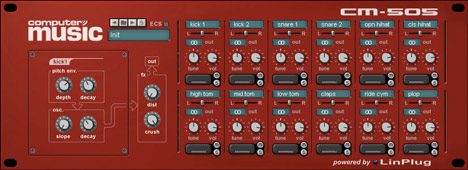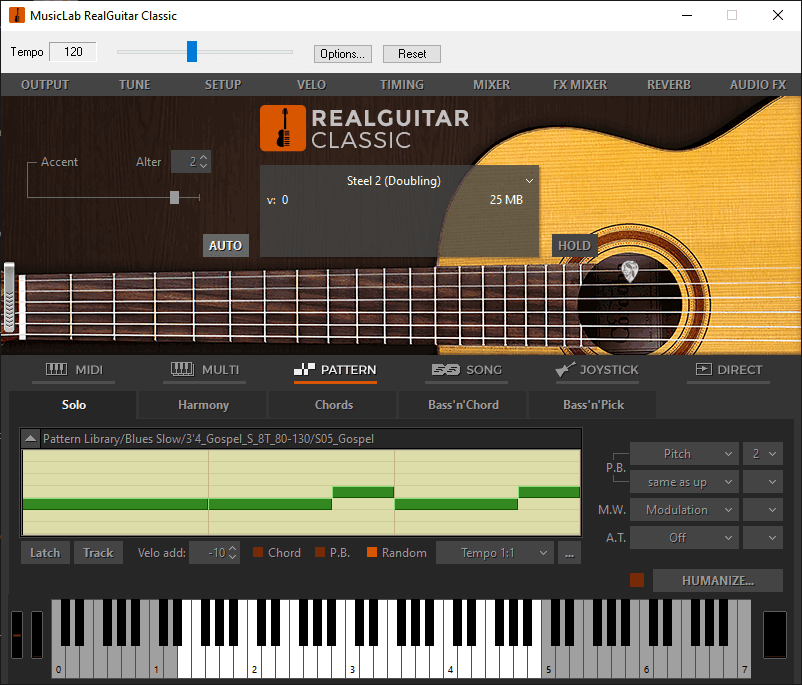

After all, if there were any even harmonics in the signal, there would have to be zero displacement at the centre of the string. Again, the proof of this is not trivial, but it makes an intuitive kind of sense. a triangle wave (see Figure 4).įigure 4: The harmonic structure of a triangle wave.Now, if the odd harmonics shown in Figure 4 conspire to create the triangle waveform shown, you might conclude that the component frequencies produced by a string plucked at its mid-point are also those of a triangle wave. Using a simple program such as Microsoft Excel, it's straightforward to show that the result of adding these oscillators' outputs is.
#REALGUITAR VST RELEASE TIME PLUCK SERIES#
You will notice that each oscillator is producing the next odd harmonic in the series (or nA, if you like, where 'n' is any odd-number integer from 1 upwards), with an amplitude of (1/n) 2 and an initial phase shifted by 180º compared with the previous. Now add a third, with frequency 5F, amplitude A/25, and phase 360º (which is the same as 0º).

Now add a second oscillator, with frequency 3F, amplitude A/9, and a starting phase of 180º. Let's suppose that you program it so that your oscillator produces a sine wave of frequency F, amplitude A, and starting phase 0º. Imagine that you have at your fingertips an additive synthesizer capable of producing numerous sine waves at the pitches and amplitudes of your choice.

This makes things simpler, as you will see. However, it's easy to visualise the result, because the starting point is a shape you know well - it's a triangle. It passes through the rest position as a straight line, becomes a trapezoid of opposite polarity, and then re-assumes its triangular shape at the opposite extreme before the forces pull it back again.īut what is the harmonic content of the waveform produced by this motion? It's not trivial to perform a harmonic analysis to determine this, but don't worry I'm not going to do the maths here. As you can see, the string loses its triangular shape, and becomes a rapidly flattening trapezoid. Figures 3(a) and 3(b), show how two waves - one travelling left to right, the other right to left - combine to produce the wave motion of the string. It's tempting to think that a string vibrating in this fashion maintains its triangular shape throughout the cycle, but this is not so. At some point soon after, the string comes to rest in the position shown in Figure 2, and at that moment the forces begin to pull it back towards its starting position. Once the string reaches this point, its tension stops accelerating it, and begins to decelerate it as it stretches in the other direction. Then you release it.Įach point on the string now starts moving towards the dashed line. In scientific terms, you have displaced the string at every point along its length, although at this instant it has zero velocity. You now use your fingertip or a plectrum to stretch the string a short way from its rest position, pulling it at its exact centre so that it becomes the red line in the diagram. Imagine that the dashed black line in the diagram is a guitar string stretched between the nut and the bridge. By now, you're all familiar with the fact that such a string is capable of vibrating at all the frequencies that comprise the harmonic series, so you may be tempted to assume that this is always the case. I'll start, as I did in Part 1 of Synth Secrets, by considering the vibration of a stretched string. The answer is yes, although if you thought brass instruments were complex sound-producing entities, you may be in for a shock this month, as I turn my attention to the principles of plucked strings and resonant bodies, and consider how these principles might help us to synthesize the sound of the acoustic guitar. You're no doubt wondering whether other instruments can be analysed in the same way. If you've been following Synth Secrets over the past four months, you'll have studied the physics of brass instruments, and seen how analogue synthesizers can recreate the essence of brass sounds.
#REALGUITAR VST RELEASE TIME PLUCK HOW TO#
Having dealt exhaustively with the mechanics of brass instruments and how to go about synthesizing them, we turn to instruments that use plucked strings to generate their sound, taking the complexities of the acoustic guitar as an example.


 0 kommentar(er)
0 kommentar(er)
